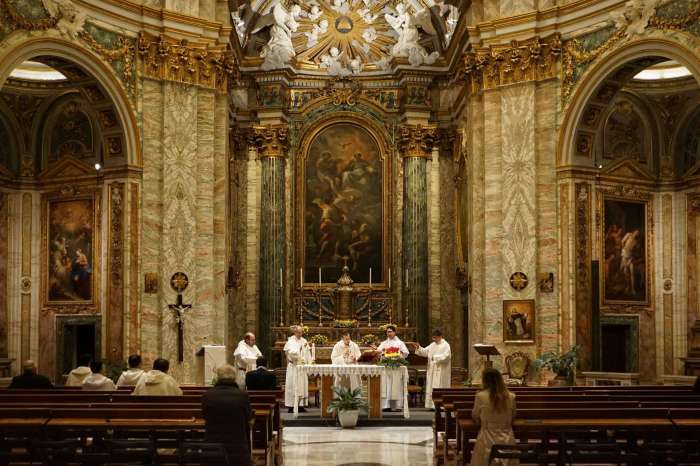New York’s surprisingly strong snow storm on January 23 forced cancellation of two of the six performances of “Tosca” scheduled for Jazz at Lincoln Center’s Rose Theater by the newly formed NYCO Renaissance company. Roy G. Niederhoffer, a former board member of the original NYCO, organized and bankrolled NYCO Renaissance and tapped Michael Capasso of the defunct Dicapo Opera Theatre as his general director.
In a sentimental gesture toward the past, the nascent company opened with the same Puccini opera that inaugurated the original New York City Opera back in February 1944. This new production recreated the original Adolfo Hohenstein set and costume designs from the 1900 world premiere of “Tosca” at the Teatro Costanzi in Rome. The performance was pleasant and respectably professional but seemed an exercise in misplaced nostalgia.
It did not resemble anything I remember from the original New York City Opera. The conductor and opening night prima donna were Dicapo stalwarts. Former Dicapo music director Pacien Mazzagatti conducted an able body of musicians billing themselves as the New York City Opera Orchestra, while Musica Sacra and the Brooklyn Youth Chorus were deputized in place of the disbanded NYCO chorus. Though Lev Pugliese was listed as the stage director, reliable informants suggested that Capasso actually directed most of the rehearsals. What transpired onstage resembled a high-end Dicapo Opera Theatre upgraded from a 200-seat church basement to a 1,000-seat opera house with a larger orchestra and budget. What was gained in higher quality playing and staging came at the cost of the modest homespun charm and intimacy of the original Dicapo experience.
Roy G. Niederhoffer, Michael Capasso field a Dicapo team to conjure NYCO
In the old days, NYCO would present cutting edge productions of the standard repertory in contrast to the lavish, traditional versions favored by the Metropolitan Opera. This was reversed this season: Luc Bondy’s stark modernistic “Tosca” played out what was rumored to be its last revival at the Met. Meanwhile, the NYCO Renaissance production featured painted cloth scenery, with Tosca entering Sant’Andrea della Valle in Act I sporting a feathered picture hat and walking stick straight from the pages of the 1912 edition of the “Victor Book of the Opera.” The original designs closely match the historical buildings familiar to the Roman audience in 1900 — much more so than Franco Zeffirelli’s grandiosities at the Met.
The painted drops were probably scaled down to fit Rose Hall’s shallow stage. The original sets likely had greater depth and visual detail than were depicted in the design sketches consulted for this production. In Act II, Scarpia’s apartment in the Palazzo Farnese looked like a watercolor blown up to life size with vague washes of pastel colors that did not suit the atmosphere of the scene.
It was interesting to see the original set configurations, though not all the original stage directions were respected. Some of the revisionist touches fell flat — Cavaradossi pulling a knife and tackling Angelotti for trespassing in the chapel? In a public space where the Marchesa Attavanti had previously visited? In Act III, the substitution of Spoletta executing Cavaradossi mafia-style with one bullet to the back of the head instead of the traditional firing squad made no sense. In reality, the bloody exit wound would have left no doubt Mario was dead, with Tosca standing only five feet away. Otherwise, it was a standard crucifix and candles affair.
“Tosca” is a vehicle for great voices, and here the company provided a mixed bag. I caught both casts, seeing the January 20 first night and the last show the following Sunday afternoon. I have admired Kristin Sampson as Violetta, Butterfly, and Tobias Picker’s Emmeline at Dicapo. As Tosca, Sampson seemed efficient but low-impact in this grander role and surroundings — her dark full lyric soprano had neither the lush beauty for a lyrical conception nor the tonal thrust for a more dramatic reading. As an actress the petite soprano hit all the marks without finding a personal interpretation.
Still, Sampson’s firm soprano has an even scale and a reliable high C — neither of which her Mario, tenor James Valenti, could count on. The tall, dashing, but dramatically awkward Valenti produced a wooden sound that unraveled in the passaggio (upper middle break). He had to break the vocal line to realign his tonal placement in order to reach isolated high notes.
Baritone Michael Chioldi absolutely stole the show as a juicy-toned, lubricious Scarpia who relished his villainy while wallowing in the masochistic guilt of false piety.
The second cast was dominated by Latonia Moore in her role debut as the Roman diva, with luscious tone and dramatic thrust easily at her command. Moore’s velvety lirico-spinto soprano thrives more on broad lyrical phrases than the agitated vocal line of verismo (her “Vissi d’Arte” broke the line with too many sobs yet still brought down the house). Her acting is dutiful rather than spontaneous. Yet this Floria provided vocal glamor and was emotionally moving.
Young Italian tenor Raffaele Abete was her Cavaradossi, unveiling a rich, slightly throaty lyric tenor, a natural instinct for Italian style, and bright high notes he wasn’t shy about flinging up to the rear balconies. Carlo Guelfi, a familiar Met Scarpia, displayed the slightly dry and juddery tone of the older veteran singer but also the dramatic and stylistic authority years of experience bring.
Mazzagatti favored broad lyrical tempos but too often got out of sync with his soloists in quicker conversational passages.
What is in the cards is uncertain: Niederhoffer and Capasso both have failed opera companies in their past. A bigger scaled Dicapo Opera Theatre is no replacement for the old New York City Opera in repertory and artistic scope. But a door has been opened for the future.
It is not as if New York has been starved for its “Tosca” fix this season. The Metropolitan Opera finished up a long run of “Tosca” performances on December 1, having presented four different divas in the title role (I saw three of them). Loft Opera has a run of “Tosca” coming up this March –– expect lots of spurting blood and a Scarpia who menaces the audience seated on the aisles and in the front row as well as the prima donna onstage!
Meanwhile at the Met, Wagnerian diva Nina Stemme donned the jeweled headdress of Puccini’s “Turandot.” Long absent from these shores, Stemme’s icy princess showed that she is still very much a diva in her prime. She lacks the tonal bulk and thrust of a Ghena Dimitrova or Gwyneth Jones (I never saw Birgit Nilsson) but surmounts the high tessitura and heavy orchestration without strain. Unfortunately, this smooth vocal approach is facilitated by dropping consonants and occasionally whole words in favor of pure vowel sounds. Instead of constantly belting, Stemme maintains clear legato phrasing utilizing a wide palette of dynamics and vocal colors. Her main strength lies in a subtly colored handling of the musical line over the full range of the role –– low notes get their full due as well as the high C’s. Pianissimos are as impressive as fortissimos.
Naturally, Stemme’s versatile soprano easily summoned warmer feminine tones in Act III when Calaf’s kiss melted her icy exterior. Her dramatic interpretation also has subtle variety –– this princess hides a pathological fear of men and intimacy under a façade of implacable mystery and cold hauteur. The frightened girl was always visible underneath the termagant.
Sadly, her Calaf was the stolidly uninspiring if reliable Marco Berti. His robust if slightly squeezed tenor has no trouble with volume or high notes. Yet the tone is shallow and monochromatic, the phrasing perfunctory –– he plowed through the music with little feeling or musical finesse. “Nessun Dorma” is usually an automatic showstopper –– Berti’s rendition merited short applause as mechanical as his performance.
Two sopranos alternated as Liù. Leah Crocetto, in her debut season at the Met, revealed a healthy, well-produced baby spinto soprano that almost matched Stemme in volume and size. A specialist in agile bel canto heroines from Rossini to early Verdi, Crocetto is a straightforward sturdy singer who needs hard music to show her mettle –– the gentle Liù doesn’t play to her strengths.
Anita Hartig who sings the role on the HD transmission on January 30th has a more delicate girlish sound with a sweet/ smoky middle register and silvery floating top. She provided greater contrast to Stemme, with Liù’s fragile vulnerability built into her tone and stage presence.
Paolo Carignani’s lyrical reading of Puccini’s complex, layered score favored the lush romantic aspects but was insufficiently agile in contrasting it with the spiky Asian-influenced fast staccato passages –– the Ping-Pang-Pong ensembles lacked speed and sparkle.
The production looked great as ever in the house and should dazzle in HD.



































